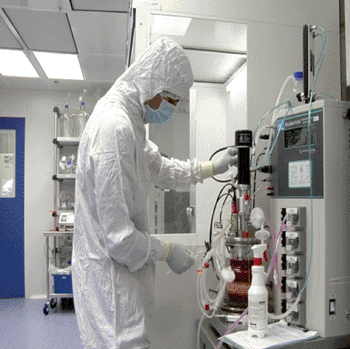Specialized Stem Cells Demonstrate Efficacy for Graft versus Host Disease Therapy
By LabMedica International staff writers
Posted on 15 Oct 2013
In a preclinical study, specially grown and expanded stem cells demonstrated efficacy for the treatment of Graft versus Host Disease (GvHD) following bone marrow transplantation in mice. A clinical path is now being investigated.Posted on 15 Oct 2013
The study was performed using “PLacental eXpanded” (PLX) cells from Pluristem Therapeutics Inc. (Haifa, Israel), a developer of cell-based therapies by expanding noncontroversial placental-derived mesenchymal stem cells via a proprietary 3D micro-environmental process, named PluriX, into therapeutics for a variety of disorders. PLX cells provide a drug delivery platform that releases a cocktail of therapeutic proteins in response to a host of local and systemic inflammatory and ischemic diseases. They require no tissue matching prior to administration, and thereby addressing part of the global shortfall of matched tissue for bone marrow transplantation (BMT).

Image: Pluristem PLacental eXpanded (PLX) cell bioreactor (Photo courtesy of Pluristem Therapeutics).
In the study conducted at the Department of Bone Marrow Transplantation of the Hebrew University, Hadassah Medical Center (Jerusalem, Israel), mice underwent total body irradiation and after 24 hours received a semi-allogeneic BMT. PLX cells, or the same volumes of the control vehicle, were then injected IV (intravenous) or IM (intramuscular) into the mice concurrently with the BMT (day 0, about 20 hours after irradiation) and 5 days postirradiation. PLX markedly reduced the GvHD score, comprised of weight loss, diarrhea, skin and fur integrity, and survival. This significant (p < 0.05) improvement in the GvHD score occurred in both the IV and IM treatment groups 42 days after transplantation. Moreover, histological examination of the liver revealed reduced hepatic lymphocyte infiltration (a marker for the severity of GvHD) occurring in the PLX-treated groups, also without preference to administration route (IV or IM).
“Based on the results of this preclinical study suggesting our PLX cells may be effective in GvHD, we are pleased with the interest of leading medical institutions to use our PLX cells and will consider a cooperation to advance into a clinical program for this indication,” said Zami Aberman, Chairman and CEO of Pluristem; “[...] this study also gives Pluristem another data point demonstrating PLX cells do not have to be given intravenously to obtain a systemic effect.” This study marks the second time that IM administration of PLX cells has demonstrated a systemic effect with efficacy in a hematological disease and the fourth time when preclinical animal models for other indications are included. Systemic, beneficial effects were also noted in three patients given (under compassionate use) PLX cells IM for bone marrow failure.
Related Links:
Pluristem Therapeutics
Hebrew University – Hadassah Medical Center














